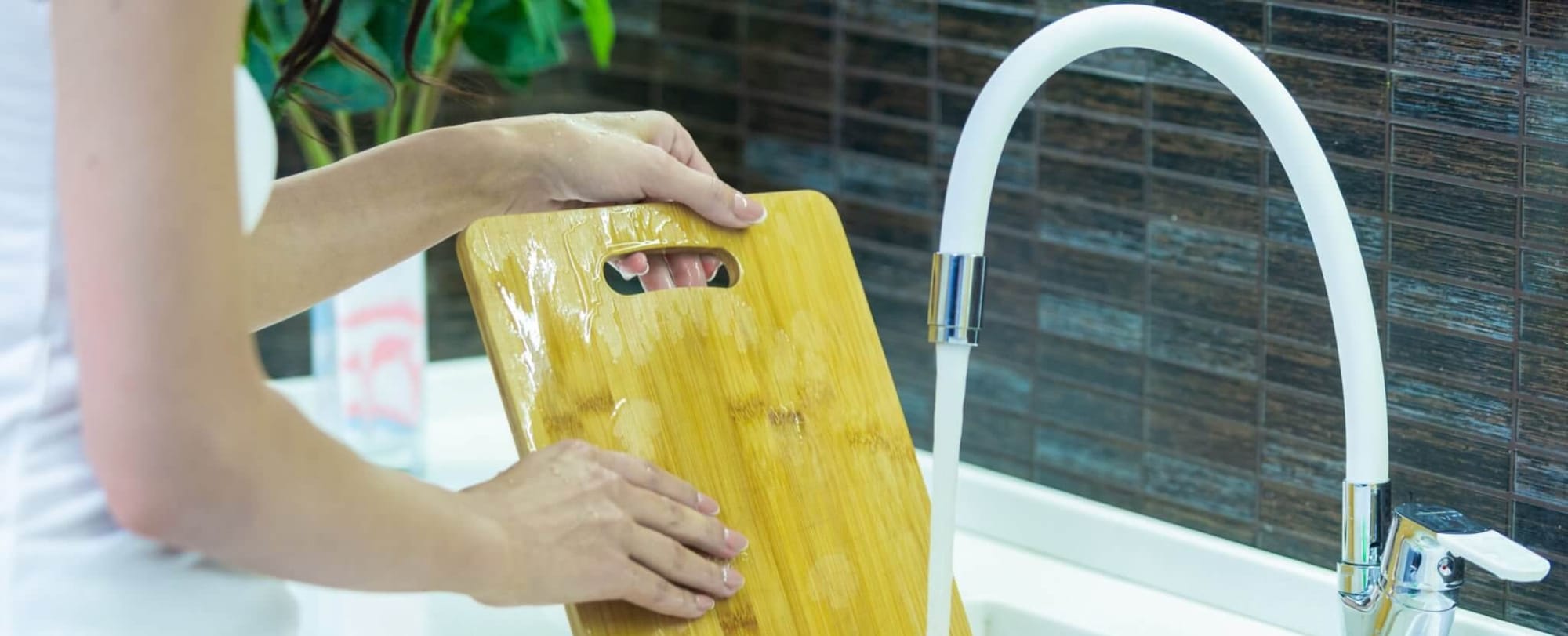Welcome to the ultimate guide on maintaining the safety and longevity of your bamboo cutting board! In the kitchen, your cutting board is the unsung hero of meal prep, but improper care, especially after handling raw meats or strong-smelling foods, can compromise food safety. This guide will walk you through the best practices for sanitizing and storing your bamboo cutting board, ensuring it remains a reliable tool in your culinary arsenal without harboring bacteria or odors.
In This Article
- Understanding Cross-Contamination
- Daily Sanitizing Steps
- Deep-Clean Sanitizing Methods
- Handling Raw Meats and Strong Odors
- Storing Your Sanitized Cutting Board
- Avoiding Cross-Use Contamination
- Natural Sanitizing Agents
- Frequently Asked Questions
Understanding Cross-Contamination

Let's chat about cross-contamination – it's when germs from one food jump onto another, like raw chicken giving a high-five to your veggies, which is not cool. This can make food unsafe and spoil your dinner party real quick. To dodge this, use separate cutting boards: one for fresh produce and another for meats. Color-code them if you can – it's like giving each food its own throne! Learn more about preventing cross-contamination in your kitchen from the USDA Food Safety and Inspection Service.
Daily Sanitizing Steps

After you've chopped and prepped, it's cleaning time! Rinse your bamboo board with some hot water, then wipe it down with a mix of vinegar and water. Vinegar is like a ninja against germs but gentle on your board. Give it a good scrub with a clean cloth, rinse again, and then let it air dry. Doing this dance after each use will keep your board spotless and ready for action.
Deep-Clean Sanitizing Methods

Every month, your board deserves a spa day for a deep clean. Mix up a solution with 1 tablespoon of baking soda, 1 tablespoon of salt, and 1 tablespoon of water. Spread this paste all over, let it sit for a few, then scrub gently. After that, spritz it with vinegar for a final germ-fighting punch. Rinse well, and let it dry. This keeps your board looking good and germ-free, which is a big win for you and your kitchen!
Handling Raw Meats and Strong Odors

When you've been working with raw meats or pungent foods, it's game time for bacteria and strong smells. To keep your bamboo board safe and scent-free, go for the one-two punch: clean and then sanitize. Scrub it down with hot soapy water first. Next, wipe it with a diluted bleach solution (about 1 tablespoon of bleach per gallon of water) or use a vinegar and water mix for a natural clean. This will zap bacteria and nix those strong odors. Rinse thoroughly after. As a bonus tip, rubbing a cut lemon across the surface can help neutralize odors, leaving your board ready for the next round of chopping without flavor mix-ups.
Storing Your Sanitized Cutting Board

After your bamboo board is clean and disinfected, make sure it's completely dry before you put it away – bacteria just love damp places. Stand it upright or hang it to allow air to circulate and water to evaporate. Find it a cool, dry spot away from the stove or sink to prevent warping or mold. This isn't just about keeping it clean; it's about making your bamboo board last longer and stay stronger, so it's always ready for your next kitchen adventure.
Avoiding Cross-Use Contamination

In the bustling environment of your kitchen, it's crucial to keep warriors separate in the battle against bacteria. Introducing separate cutting boards for raw meats, vegetables, and ready-to-eat foods isn't just good practice—it's a shield against the invisible enemy: cross-contamination. This simple step ensures that harmful bacteria from raw foods can't make a leap onto your veggies or ready-to-snack fruits. Think of it as assigning different players to their positions in a game, where each one knows exactly where to shine without stepping onto another's turf.
Natural Sanitizing Agents

Chemicals aren't the only heroes in the fight against germs; nature has gifted us with potent allies. For your bamboo cutting board, embracing natural sanitizing agents means you can effectively banish bacteria without compromising the board's integrity or your health. White vinegar and hydrogen peroxide are like the dynamic duo of natural cleaning, each bringing their strength to the fight—vinegar with its acidity and peroxide with its bubbling, oxygen-powered action. Alternating between these two can ensure your board is not just clean, but sanitized, all without leaving harmful residues behind.
Frequently Asked Questions
Can I use vinegar to sanitize my bamboo cutting board after cutting meat?
Yes, vinegar is an effective natural sanitizer that can be safely used on bamboo cutting boards.
How long should I let my bamboo cutting board dry before storing it?
Allow it to dry completely, which can take several hours. Overnight drying is often a good practice.
Is it safe to cut different types of food on the same bamboo cutting board?
Yes, but it’s crucial to clean and sanitize the board between uses, especially when switching from raw meat to vegetables or other ready-to-eat foods.
Can bleach be used on bamboo cutting boards?
While diluted bleach can be used sparingly for disinfection, natural alternatives like vinegar are recommended to avoid damaging the bamboo.





